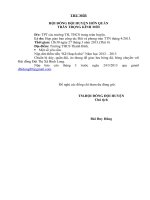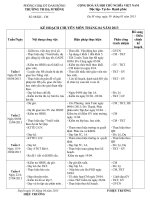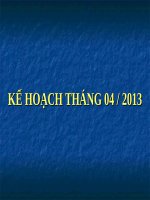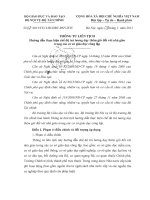Astm f 565 04 (2013)
Bạn đang xem bản rút gọn của tài liệu. Xem và tải ngay bản đầy đủ của tài liệu tại đây (61.95 KB, 2 trang )
Designation: F565 − 04 (Reapproved 2013)
Standard Practice for
Care and Handling of Orthopedic Implants and Instruments1
This standard is issued under the fixed designation F565; the number immediately following the designation indicates the year of original
adoption or, in the case of revision, the year of last revision. A number in parentheses indicates the year of last reapproval. A superscript
epsilon (´) indicates an editorial change since the last revision or reapproval.
1. Scope
3. Receiving Implants and Instruments
1.1 This practice covers recommended procedures for the
handling of orthopedic implants and instruments.
3.1 Receipt:
3.1.1 Many implants are wrapped in special sterilizable or
pre-sterilized packages, envelopes, or other containers. These
wrappings should not be removed by the receiving personnel.
3.1.2 Carefully unwrap and handle non-sterilized implants
and instruments upon receipt to avoid scratching, marking, or
abrasion by other implants, instruments, unpacking tools, or by
dropping or otherwise endangering the surface finish or configuration.
1.2 Hospital receiving personnel, central supply personnel,
operating room personnel, surgeons, and occasionally other
individuals will handle orthopedic implants and instruments.
All personnel should be informed of recommended care and
handling procedures to prevent damage to orthopedic implants
and instruments.
1.3 This practice does not cover producer level handling
and packaging procedures.
3.2 Transport—Perform transport in a manner to preclude
any damage or alteration to the received condition of the
implant or instrument.
1.4 The values stated in SI units are to be regarded as
standard. No other units of measurement are included in this
standard.
1.5 This standard does not purport to address all of the
safety concerns, if any, associated with its use. It is the
responsibility of the user of this standard to establish appropriate safety and health practices and determine the applicability of regulatory limitations prior to use.
3.3 Storage:
3.3.1 Store implants or instruments prior to use in such a
manner as to maintain the device’s surface finish or
configuration, or both.
3.3.2 Many implants are identified by a serial or lot number,
or both, on the package label, package insert, or surface of the
device. Record these control numbers and retain for transfer to
patient records, to facilitate inventory, stock rotation, medical
device reporting, and possible traceability to the manufacturer.
3.3.3 Stock Rotation—The principle of first in, first out, is
recommended.
3.3.4 Store implants in the operating room in such a manner
as to isolate and protect the implant’s surface, sterility, and
configuration. Keep implants made of different metals separated.
3.3.5 Store the implants and instruments in the operating
room in such a manner as to isolate the instruments from the
implants.
2. Terminology
2.1 Definitions of Terms Specific to This Standard:
2.1.1 orthopedic implant—a device introduced by surgically
penetrating the skin or mucosa of the body with the intention
that it remain within or attached to the skeleton within the body
following the surgery. This device is referred to in this practice
as an “implant.”
2.1.2 orthopedic instrument—any cooperative device used
during surgical procedures involving the implantation of orthopedic implants. This device is referred to in this practice as
an “instrument.”
4. Handling
4.1 Mixing Metals—Maintain orthopedic implants and instruments of different metals separately to avoid the possibility
of mixing during surgery.
4.2 Cleaning and Sterilization:
4.2.1 Prior to initial sterilization and promptly following
each surgical procedure, thoroughly and carefully clean all
instruments and implants. Ultrasonic cleaners, mechanized
washers, or hand scrubbing are suitable methods, if carefully
done. The method employed should be utilized to prevent
1
This practice is under the jurisdiction of ASTM Committee F04 on Medical and
Surgical Materials and Devices and is the direct responsibility of Subcommittee
F04.21 on Osteosynthesis.
Current edition approved Oct. 1, 2013. Published October 2013. Originally
approved in 1978. Last previous edition approved in 2009 as F565 – 04 (2009)ε1.
DOI: 10.1520/F0565-04R13.
Copyright © ASTM International, 100 Barr Harbor Drive, PO Box C700, West Conshohocken, PA 19428-2959. United States
1
F565 − 04 (2013)
4.4.2 It is recommended that metallic orthopedic implants
should not be sharply bent, re-bent, angulated at a screw hole,
notched, or scratched.
4.4.3 Reshaping or contouring may cause complete loss of
performance for instruments. It is recommended that orthopedic instruments be handled with care to prevent costly reworking or destruction. If modifications are necessary, the instrument should not be sharply bent, re-bent, or angulated.
4.4.4 Orthopedic instruments in general have a long service
life, but mishandling or inadequate protection can quickly
diminish the instrument’s life expectancy.
4.4.5 Dispose of instruments whose performance capabilities have been jeopardized by mishandling or improper care.
impact, scratching, bending, or surface contact with any
materials that might affect the implant or instrument surface or
configuration.
4.2.2 Closely follow the manufacturer’s recommendations
on cleaning. When hand scrubbing, use soft brushes and avoid
harsh chemicals or harsh cleaning solutions.
4.2.3 After cleaning, rinse the orthopedic implants and
instruments completely free of all residuals, soap, detergent, or
cleaning solutions. Following rinsing, dry them thoroughly.
Devote special attention to hinges, pivots, box locks, and other
recesses since these are points that entrap both chemicals and
rinse water.
4.2.4 Lubricate instruments that require lubrication immediately after drying. Follow the recommendations of the
manufacturers of such instruments explicitly as to the method,
type, and amount of lubricant. Insufficient or excessive lubrication can be nearly as disastrous as no lubrication.
4.2.5 Carry out sterilization by steam autoclaving or other
methods in a manner that protects the integrity of the implants
and instruments.
4.2.6 Sterilize implants and instruments of polymeric
materials in accordance with methods recommended by the
manufacturer.
4.2.7 Do not sterilize implants in contact with instruments
or implants of other materials. Metallic oxide could transfer to
the implant, initiating an unacceptable conditioning.
4.2.8 Do not expose instrumental cutting edges and teeth to
the hazard of dulling.
5. Reuse
5.1 Avoid the reimplantation of previously implanted orthopedic implants.
5.2 Trial fitting of an orthopedic implant in a patient,
followed by proper cleaning and sterilization if not immediately implanted in the same patient, may not in all instances be
considered as reimplantation. The user is cautioned that any
mechanical alteration of the components (for example, plate
bending), coating damage, or surface damage (for example,
nicks, dents, and scratches) should prevent the device from
being reimplanted. In addition, certain coatings (porous
coating, hydroxyapatite (HA)) may not be able to be recleaned
or resterilized, or both, while properly maintaining the integrity
of the implant. The user should refer to the manufacturer’s
instructions for guidance; or, in their absence, the device
should not be reimplanted.
4.3 Appearance—Dispose of orthopedic implants that exhibit surface or configuration damage.
4.4 Contouring and Modifying Implants and Instruments:
4.4.1 Contouring or clamping of orthopedic implants, when
necessary, shall be performed by the surgeon in a manner that
will least damage the implant.
6. Keywords
6.1 handling of implants; instruments; material handling
ASTM International takes no position respecting the validity of any patent rights asserted in connection with any item mentioned
in this standard. Users of this standard are expressly advised that determination of the validity of any such patent rights, and the risk
of infringement of such rights, are entirely their own responsibility.
This standard is subject to revision at any time by the responsible technical committee and must be reviewed every five years and
if not revised, either reapproved or withdrawn. Your comments are invited either for revision of this standard or for additional standards
and should be addressed to ASTM International Headquarters. Your comments will receive careful consideration at a meeting of the
responsible technical committee, which you may attend. If you feel that your comments have not received a fair hearing you should
make your views known to the ASTM Committee on Standards, at the address shown below.
This standard is copyrighted by ASTM International, 100 Barr Harbor Drive, PO Box C700, West Conshohocken, PA 19428-2959,
United States. Individual reprints (single or multiple copies) of this standard may be obtained by contacting ASTM at the above
address or at 610-832-9585 (phone), 610-832-9555 (fax), or (e-mail); or through the ASTM website
(www.astm.org). Permission rights to photocopy the standard may also be secured from the ASTM website (www.astm.org/
COPYRIGHT/).
2









